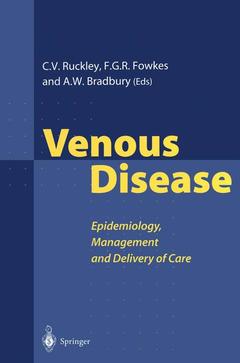Description
Venous Disease, Softcover reprint of the original 1st ed. 1999
Epidemiology, Management and Delivery of Care
Coordinators: Ruckley Charles V., Fowkes Francis G.R., Bradbury Andrew W.
Language: English
Subjects for Venous Disease:
Keywords
classification; drug; endoscopy; epidemiology; etiology; health care; hospital; hospitals; outcome; pathogenesis; quality; quality of life; surgery; therapy; ultrasound
Publication date: 09-2011
278 p. · 15.5x23.5 cm · Paperback
278 p. · 15.5x23.5 cm · Paperback
Description
/li>Contents
/li>Comment
/li>
Varicose veins are a very common problem. The precise aetiology of primary varicose veins remains unclear. It seems likely from the available evidence that inherited structural weakness combined with haemodynamic or microcirculatory abnormalities eventually lead to reduced vein wall elasticity, dilatation and the formation of varicosities. Increasing age, female gender, parity and occupation may all promote the development of varicose veins in susceptible individuals. Further clinical and experimental studies are necessary if the relative contribution of each of these factors is to be fully elucidated. References 1. Editorial. The treatment of varicose veins. Lancet 1975;ii:311. 2. Prerovsky I. Diseases of the veins. World Health Organisation, internal communication, MHO-PA 10964. 3. Weddell JM. Varicose veins: pilot study. Br J Surg 1969;23:179-186. 4. Hobsley M. Pathways in surgical management. 2nd ed. London: Edward Arnold, 1986. 5. Browse NL, Burnand KG, Lea Thomas M. Diseases of the veins. London: Edward Arnold, 1988. 6. Logan WPD, Brooke EM. The survey of sickness. Studies on medical and population subjects no. 12. London: General Register Office, 1957. 7. The committee on the Danish national morbidity survey. The sickness survey of Denmark. Copenhagen, 1960. 8. US Department of Health. Education and welfare: national health survey 1935-1936. Washington, DC, 1938. 9. The Department of National Health and Welfare and the Dominion Bureau of Statistics. Illness and health care in Canada. Canadian Sickness Survey 1950-1951. Ottawa, 1960.
Section I: Epidemiology and Aetiology.- 1 How Common Is Venous Disease in the General Population?.- 2 Leg Ulcer and Chronic Venous Insufficiency in the Community.- 3 What Are the Risks of Thrombophilia?.- 4 Does Lifestyle Really Affect Venous Disease?.- 5 What Makes Veins Varicose?.- 6 How Does a Leg Ulcerate?.- Section II: Diagnosis and Measurement.- 7 How Should Venous Disease Be Classified?.- 8 How Do We Select the Appropriate Tests of Venous Function?.- 9 Imaging of Chronic Venous Disease.- 10 Venous Symptoms and Signs and the Results of Duplex Ultrasound: Do They Agree?.- Section III: Clinical Management.- 11 Compression Therapy. Is It Worthwhile?.- 12 What is the Place of Sclerotherapy?.- 13 Perforator Surgery: What Is Its Role?.- 14 Can We Tailor Surgery to the Venous Abnormality?.- Section IV: Priorities for Treatment.- 15 Medical Treatment for Venous Diseases.- 16 Telangiectasia: Is Treatment Worthwhile and Who Should Pay?.- 17 Which Patients Should be Selected for Venous Surgery?.- 18 NHS and Independent Provision of Varicose Vein Surgery: A Rational Basis for Case Selection.- 19 How Can Evidence on Treating Venous Disease be Rationalised?.- Section V: Delivery of Care.- 20 Should Every Patient with Chronic Venous Disease Have a Duplex Scan?.- 21 How To Run an Efficient Venous Service?.- 22 What Is the Scope of Day Care for Venous Surgery?.- 23 Hospital or Community: How Should Leg Ulcer Care be Provided?.- 24 What Are the Costs of Treating Venous Disease?.- Section VI: Improving Outcomes.- 25 How Do We Prevent Recurrence of Varicose Veins?.- 26 How Can We Improve Outcomes for Leg Ulcer Patients?.- 27 Quality of Life for Leg Ulcer Patients?.- 28 Developing and Implementing Leg Ulcer Guidelines?.
Text has been prepared by an international group of expert authors
Uses a broadly-based approach to venous disease and original, high quality data
Tackles controversial clinical and management problems
© 2024 LAVOISIER S.A.S.
These books may interest you

Handbook of Venous and Lymphatic DisordersGuidelines of the American Venous Forum, Fourth Edition 220.72 €

New findings in vascular surgery 124.51 €


